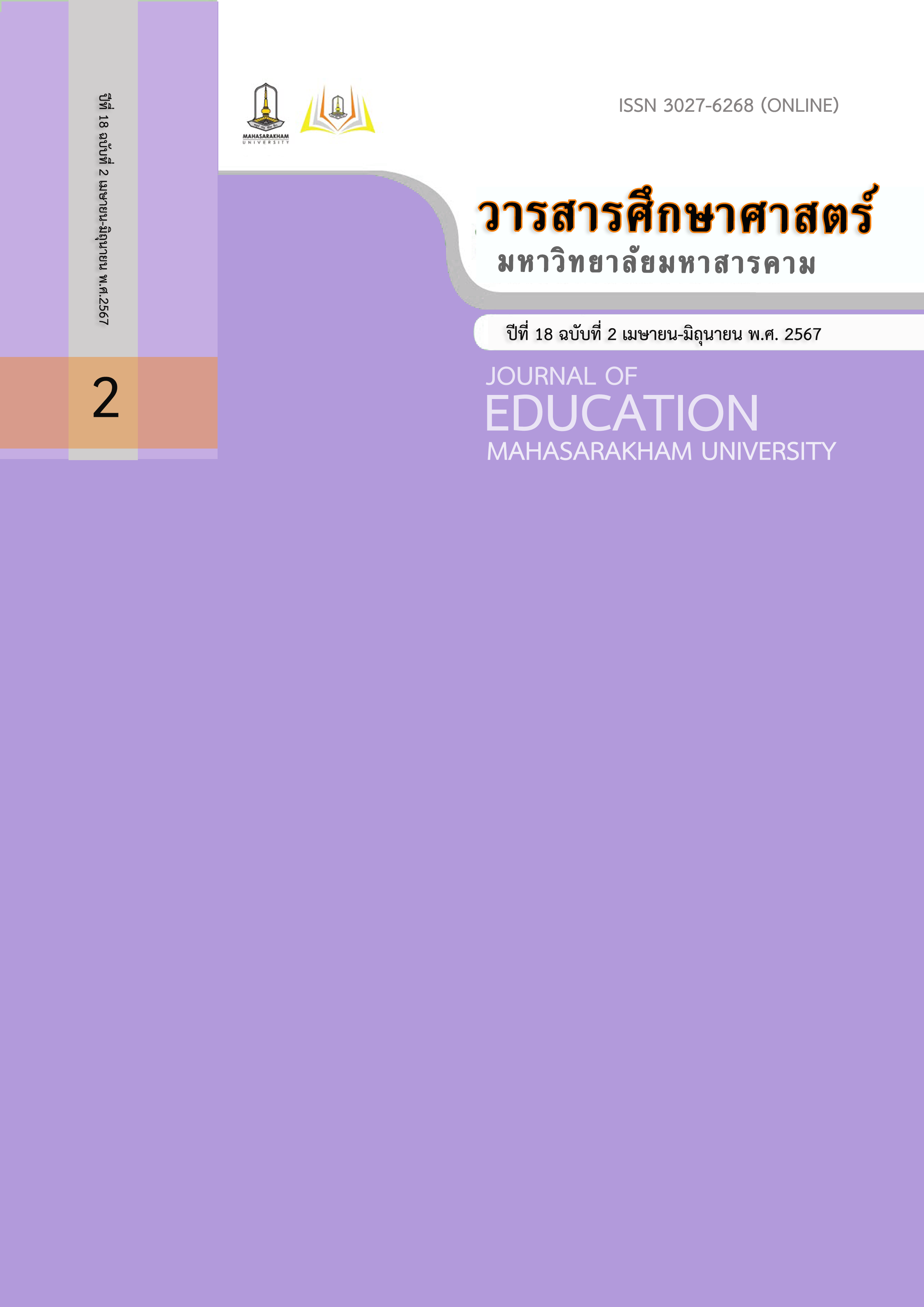Digital Game Design with the ARCS Model to enhance Concentration for Attention Deficit Hyperactivity Disorder (ADHD) Children
Main Article Content
Abstract
This research aimed to investigate the design principles of digital games utilizing the ARCS model (Attention, Relevance, Confidence, and Satisfaction) to enhance attention in children with Attention Deficit Hyperactivity Disorder (ADHD). Children with ADHD, characterized by an inability to inhibit themselves, restlessness, and a lack of sustained attention, can benefit from learning stimulation through interactive game play. Therefore, this qualitative research delved into the design of digital games using the ARCS model to ensure effectiveness and appropriateness for children with ADHD. Thirteen participants, comprising experts in ADHD, educational technology, game design and development, as well as children with ADHD, were selected through purposive sampling. Descriptive statistics analysis was employed to analyze the data gathered from in-depth interviews. The research results yielded design guidelines for digital games integrated with the ARCS model, encompassing content selection, game format, storyline development, duration, graphic design, typography, color tones, sound effects, and interactive screen design. Furthermore, instructional design principles were applied, progressing from easy to difficult levels, with appropriately reinforced motivation. The outcomes of this research, in line with the aforementioned principles, provide guidance for the effective design of digital games that stimulate learning and motivation in children with ADHD. These findings served as a foundation for designing instructional media to enhance the attention in children with ADHD in future applications.
Downloads
Article Details

This work is licensed under a Creative Commons Attribution-NonCommercial-NoDerivatives 4.0 International License.
References
ทวีศักดิ์ สิริรัตน์เรขา. (2561). คู่มือการดูแลสุขภาพจิตเด็ก กลุ่มปัญหาการเรียน (พิมพ์ครั้งที่ 2), กรุงเทพฯ: พรอสเพอรัสพลัส
ทศพร สร้างนานอก, วรากร ทรัพย์วิระปกรณ์ และ ศศินันท์ ศิริธาดากุลพัฒน์. (2562). การพัฒนาเกมเสริมสร้างความตั้งใจจดจ่อในนักเรียนชั้นประถมศึกษา, วารสารพยาบาลทหารบก, 21(1), 338-340.
ทัศนีย์พร สวรรณเขตร์. (2557). การออกแบบสื่อแอนิเมชันสำหรับเด็กสมาธิสั้น โดยเน้นเรื่องสี. การประชุมวิชาการระดับชาติ ประจำปี 2557 (National Research Conference 2014), 401-404.
ปิยนันท์ ปานนิ่ม. (2549). ผลของการใช้รูปแบบการเสริมแรงทางบวกในการเรียนรู้โดยใช้เกมเป็นฐานบนเว็บที่มีต่อผลสัมฤทธิ์ทางการเรียนวิชาคณิตศาสตร์ของนักเรียนประถมศึกษาปีที่ 2 ที่มีสมาธิสั้นและมีพฤติกรรมอยู่ไม่นิ่ง, วิทยานิพนธ์ครุศาสตรมหาบัณฑิต, จุฬาลงกรณ์มหาวิทยาลัย, กรุงเทพฯ.
พบแพทย์. (2560). การมีสุขภาพดี : ประโยชน์ของการนั่งสมาธิ. https://www.pobpad.com/ประโยชน์ของการนั่งสมาธิ
พระสรณ์สิริ ปชฺชลิโต (โททอง). (2561). การเปรียบเทียบระดับสมาธิตามแนวพุทธศาสนาของพระภิกษุสงฆ์ไทยจำแนกตามระดับพรรษา:การศึกษาคลื่นไฟฟ้าสมอง, วิทยานิพนธ์ ครุศาสตรดุษฎีบัณฑิต, มหาวิทยาลัยบูรพา, ชลบุรี
รติยา ภมรปฐมกุล และ ทศพร แสงสว่าง. (2558). บทเรียนคอมพิวเตอร์ช่วยสอนรูปแบบเกม เรื่องการบวกและการลบจำนวนเต็มสำหรับเด็กสมาธิสั้น ระดับประถมศึกษาปีที่ 3. วารสารครุศาสตร์อุตสาหกรรม มหาวิทยาลัยเทคโนโลยีราชมงคลธัญบุรี, 3(2), 128-144.
สถาบันราชานุกูล. (2552). คู่มือผู้ปกครอง...ใส่ใจเด็กวัยเรียน (พิมพ์ครั้งที่ 1). กรุงเทพฯ:โรงพิมพ์ชุมนุมสหกรณ์การเกษตรแห่งประเทศไทย จำกัด
Cibrian, F. L., Lakes, K. D., Schuck, S. E. B., Hayes, G. R. (2022). The potential for emerging technologies to support self-regulation in children with ADHD: A literature review, International Journal of Child-Computer Interaction, 31.
Crepaldi, M.; Colombo, V.; Mottura, S.; Baldassini, D.; Sacco, M.; Cancer, A.; Antonietti, A. (2020). Antonyms: A Computer Game to Improve Inhibitory Control of Impulsivity in Children with Attention Deficit/Hyperactivity Disorder (ADHD). Information, 11, 230. https://doi.org/10.3390/info11040230
Kaneko, K., Saito, Y., Nohara, Y., Kudo, E., Yamada, M. (2015). A Game-Based Learning Environment Using the ARCS Model at a University Library, 4th International Congress on Advanced Applied Informatics.
Keller, J.M. (1987). Development and Use of the ARCs Model of Instructional Design. Journal of Instructional Development, 10(2).
Meysamie, A., Fard, M. D., Mohammadi, M. R. (2011). Prevalence of Attention-Deficit/Hyperactivity Disorder Symptoms in Preschool-aged Iranian Children. Iran J Pediatr. 21(4), 467-472.
Ochi, Y., Laksanasopin, T., Kaewkamnerdpong, B., Thanasuan, K. (2017). Neurofeedback game for attention training in adults, The 2017 Biomedical Engineering International Conference (BMEiCON-2017).
Pan, F., Zhang, L., Ou, Y., Zhang, X. (2019). The audio-visual integration effect on music emotion: behavioral and physiological evidence. PLoS One, 14(5).
Putra, A., Spits Warnars, H. L. H., Abbas, B., Trisetyarso, A., Suparta, W., & Kang, C. (2018). Gamification in the e-Learning Process for children with Attention Deficit Hyperactivity Disorder (ADHD), 2018 Indonesian Association for Pattern Recognition International Conference (INAPR), 182-185.
Sayal, K., Prasad, V., Daley, D., Ford, T., Coghill, D. (2018). ADHD in children and young people: prevalence, care pathways, and service provision. The Lancet Psychiatry. 5(2), 175–186. doi: 10.1016/S2215-0366(17)30167-0.S2215-0366(17)30167-0
Tomé, R.M., Pereira, J.M., Oliveira, M. (2014). Using Serious Games for Cognitive Disabilities. International Conference on Serious Games Development and Applications (SGDA 2014), 34-47. https://doi.org/10.1007/978-3-319-11623-5_4


